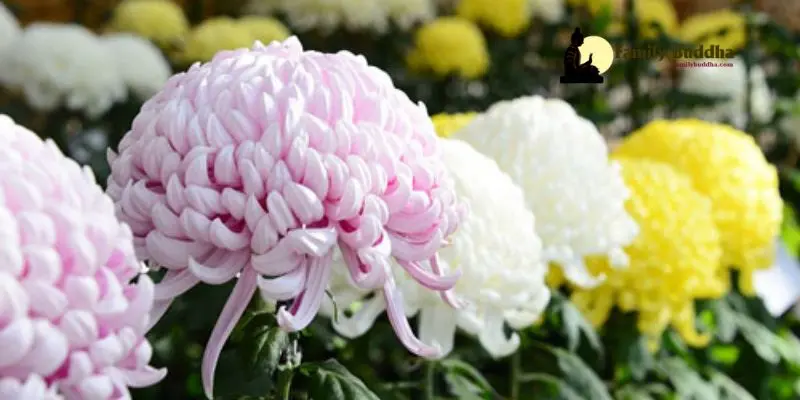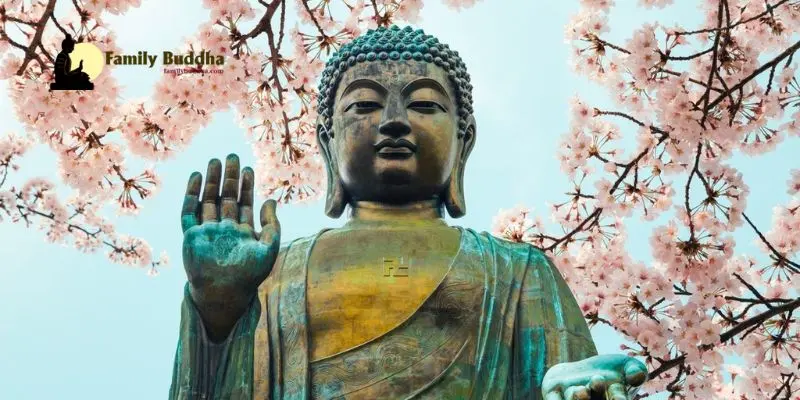The tranquility of the Buddhist realm is mirrored in flowers, which symbolize purity, impermanence, and the natural cycles of life that emerge and then diminish. It is traditional to present flowers when visiting temples, but the flowers chosen for rituals carry deep significance and beauty. Today, Familybuddha.com. will explore the symbolic flowers in Buddhism associated with spiritual symbolism and profound spiritual meanings.
Lotus: Symbol of Enlightenment

The lotus flower, which grows in murky waters but blooms beautifully above the surface, is a symbol often associated with Buddhism. It symbolizes overcoming challenges and finding inner peace. In Buddhist philosophy, the lotus is used to represent different stages of personal development. Those who have let go of worldly desires are likened to the lotus above water, while those beginning to understand spiritual truths are compared to a budding lotus.
The lotus beneath the water requires ongoing effort and practice, similar to individuals still learning the teachings of Buddhism. Despite initial struggles, everyone has the potential to grow and blossom like a lotus that rises above the water.
Chrysanthemum: Embracing Impermanence

Jasmine, renowned for its exquisite fragrance, occupies a revered place within Buddhist traditions, where its symbolic significance transcends its mere floral essence. Beyond its aromatic allure, jasmine embodies profound spiritual virtues that resonate deeply with the core tenets of Buddhism.
Its delicate blooms, evocative of purity and innocence, serve as a potent reminder of the fundamental principles of compassion and empathy espoused by the Buddha. In the practice of mindfulness, jasmine assumes a pivotal role, its intoxicating scent acting as a conduit for heightened awareness and attunement to the present moment. Through the offering of jasmine, practitioners seek to cultivate pure intentions and align their words and deeds with the noble ideals of benevolence and virtue.
The subtle yet transformative power of jasmine is believed to uplift the mind and soothe the soul, fostering a sense of inner peace and harmony conducive to spiritual growth and enlightenment. In the gentle fragrance of jasmine, Buddhists find a sacred reminder to navigate life’s complexities with grace and kindness, honoring the interconnectedness of all living beings and the universal quest for inner fulfillment.
Jasmine: Compassion and Purity

Jasmine, renowned for its exquisite fragrance, occupies a revered place within Buddhist traditions, where its symbolic significance transcends its mere floral essence. Beyond its aromatic allure, jasmine embodies profound spiritual virtues that resonate deeply with the core tenets of Buddhism. Its delicate blooms, evocative of purity and innocence, serve as a potent reminder of the fundamental principles of compassion and empathy espoused by the Buddha.
In the practice of mindfulness, jasmine assumes a pivotal role, its intoxicating scent acting as a conduit for heightened awareness and attunement to the present moment. Through the offering of jasmine, practitioners seek to cultivate pure intentions and align their words and deeds with the noble ideals of benevolence and virtue.
The subtle yet transformative power of jasmine is believed to uplift the mind and soothe the soul, fostering a sense of inner peace and harmony conducive to spiritual growth and enlightenment. In the gentle fragrance of jasmine, Buddhists find a sacred reminder to navigate life’s complexities with grace and kindness, honoring the interconnectedness of all living beings and the universal quest for inner fulfillment.
Marigold: Symbol of Radiance

Marigolds, with their vibrant colors and cheerful demeanor, have long been revered as symbols of radiance and spiritual significance, particularly in Buddhist practices. Beyond their ornamental value, marigolds hold a special place in Buddhist rituals and ceremonies, adorning altars and sacred spaces around temples in various Buddhist traditions.
The bright hues of marigolds are often interpreted as representations of vitality, enlightenment, and the journey toward spiritual awakening. In Buddhist symbolism, the radiant petals of marigolds are associated with the inner light of wisdom and knowledge that illuminates the path to enlightenment.
Moreover, marigolds are seen as embodiments of empathy and compassion, virtues central to Buddhist teachings. The flower’s resilience and ability to thrive in diverse environments serve as metaphors for the strength and perseverance required on the spiritual journey.
In Buddhist culture, offering marigolds is considered a gesture of reverence and devotion, reflecting a sincere commitment to the pursuit of wisdom and understanding. Through their vibrant presence in sacred spaces, marigolds inspire practitioners to cultivate inner radiance and compassion as they progress along the path of spiritual growth and enlightenment.
Orchid: Tranquility and Beauty

Orchids, with their delicate and intricate blossoms, hold a revered place within Buddhist symbolism, embodying notions of beauty, tranquility, and spiritual depth. Far beyond mere floral adornments, orchids serve as potent metaphors for the profound shifts in consciousness and inner serenity sought by practitioners of Buddhism. In the rich tapestry of Buddhist artwork and iconography, orchids are often depicted as symbols of grace and composure, their ethereal beauty mirroring the serene countenance of enlightened beings.
The fragility of orchids serves as a reminder of the impermanence inherent in all existence, prompting contemplation on the transient nature of life and the impermanence of worldly attachments. Moreover, the intricate complexity of orchid blooms mirrors the intricate workings of the mind, inviting individuals to embark on a journey of self-discovery and inner exploration in pursuit of heightened awareness and wisdom.
Just as orchids require tender care and nurturing to flourish, so too do practitioners of Buddhism endeavor to cultivate mindfulness and compassion in their daily lives, fostering a state of inner peace and harmony amidst life’s tumultuous currents. Through their symbolic resonance, orchids inspire reverence for the natural world and serve as gentle reminders of the timeless truths elucidated by the Buddha, guiding aspirants along the path toward enlightenment and spiritual fulfillment.










